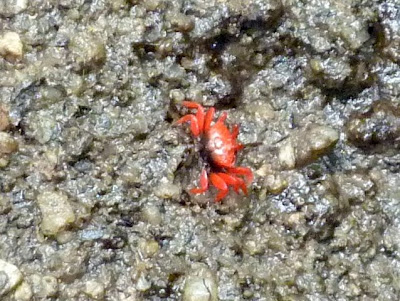On 20th May, a bunch of Biology trainee teachers had a field trip visit to Sungei Buloh Wetlands Reserve. I went about an hour earlier in hope to catch the recent hype of otters and crocodiles that have been regularly sighted. Crocodile at Sungei Buloh from Loh Kok Sheng on Vimeo.
Though the otters were hiding, I was very excited to see the Estuarine crocodile (Crocodylus porosus)! It's my first time seeing a wild one!
The crocodile is really huge. And it just swims very calmly on the surface!
Juvenile crocodiles eat insects, frogs, crabs and fishes while the adults eat larger prey including fish, birds and mammals, hunting mainly at night.
Here's a short video of the crocodile swimming!
Sometimes mistaken for crocodiles, Sungei Buloh has many of these Malayan water monitor (Varanus salvator). Although mainly terrestrial, the water monitor can climb trees and also swims well. It can even dive underwater.
I noticed a pack of feral dogs at the mangroves too. They are likely to come from the farms nearby as they do not originally belong to Sungei Buloh. These dogs are threats to wildlife such as birds and otters. Find out more about these dogs in Samson's blog post.
In no time, the trainee teachers have arrived as well as our guide. And our guide is none other than Cynthia! It was nice to have her with us.
So off we went first to explore the boardwalk section of the mangroves. We discussed about many lifeforms along the way as well as other ecological concepts that we can share with the students in the future.
Allen came across this pair of furry worm-like creatures which are probably caterpillars?
And there were a number of the very cute yet tiny Red eyed stalk fiddler crabs that we came across before at Chek Jawa boardwalk too.
There were quite a number of the huge Giant mudskippers (Periophthalmodon schlosseri) along the edge of the water.
Mudskippers are fishes! How do they then breathe out of water?
While out of water, they breathe by retaining water in enlarged gill chambers. Just as we bring tanks of air to breathe from when we scuba dive, mudskippers bring stores of water within their cheeks. They can also breathe air through their wet skin. These fish are in fact more comfortable crawling around on the mud than submerged in water!
Unfortunately, we also saw quite a number of mangrove trees that have fell which is probably due to soil erosion.
Read more about the erosion from this news article posted in 2008.
On our way back, we caught a glimpse of some terrestrial animals such as this cute Plantain Squirrel (Callosciurus notatus). It eats fruits, seeds, leaves, bark and insects, foraging in the trees.
Last but definitely not the least, I had my first close encounter with this Flying Dragon (Draco sumatranus)!
Why is it called the flying dragon? It is because they have a flap of skin extending from each side of their bodies, supported by their long ribs. With this, flying dragons can glide (instead of fly) from place to place by spreading out its ribs (like opening a fan).
Here's a closeup of this cute little dragon. :)
More photos of the day's trip here: http://www.flickr.com/photos/koksheng/archives/date-taken/2010/05/20/
Sunday, June 6, 2010
NIE field trip to Sungei Buloh
Subscribe to:
Post Comments (Atom)



















No comments:
Post a Comment